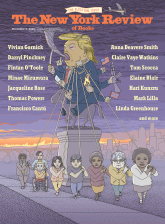In response to:
The New Nuclear Threat from the August 20, 2020 issue
To the Editors:
In her review of recent books on nuclear forces and those who think about them, Jessica Mathews [“The New Nuclear Threat,” NYR, August 20] proceeds from the cold war–era conceptualization involving use by great powers of selected portions of their arsenals in a way that can be “clearly signaled…accurately interpreted by the other side, and responded to not in rage or fear but with calm reasonableness.” She doubts this is possible, for good reason.
An alternative take on “limited” nuclear war would be to consider the point of view of the post–cold war class of smaller nuclear powers. Their strategic focus is not lashed to the larger global competition of the great powers Dr. Mathews focuses on (as was that of nuclear-armed UK, France, and China during the cold war). Their use of nuclear weapons would be limited by the relatively few they have at their disposal. It is not clear that, say, India and Pakistan accept the cold war–era redline on use of these weapons created by “effective deterrence, fear of their destructiveness, and a…taboo against their use” even though they doubtless are well aware of the horrors the use of such weapons would involve. In a conflict involving this dyad or, someday, the one enmeshing Israel and Iran, the combatants might well decide they are willing to treat their limited numbers of nuclear weapons as precious, vulnerable, potentially decisive assets best used in a first strike once fighting has begun. In particular, Pakistan has suffered from India’s numerical superiority in previous conventional wars and may well not be willing to replay this script.
Rather than thinking in terms of deterrence and taboos, smaller nuclear powers might use nuclear weapons like any other weapons. During the heat of the opening rounds of a new war they might coldly calculate the counterforce and countervalue options permitted or precluded by the size and range of their arsenals, their estimates of their enemy’s capabilities and intentions, and their overall strategy for whatever they think constitutes victory. Chances are that pressures on them to conform to cold war–era shibboleths regarding nuclear use from the inaptly termed “international community” might no longer be enough to hold them back.
In addition, of course, we should think about North Korea…
David B. Kanin
Adjunct Professor of European Studies
School of Advanced International Studies
Johns Hopkins University
Washington, D.C.
Jessica T. Mathews replies:
Professor Kanin is of course correct that the new nuclear powers—India, Pakistan, Israel, and North Korea—may think differently about the use of these weapons than do the original five. Importantly, they also think very differently from one another. India and Pakistan, for example, are generally considered the world’s most likely nuclear flashpoint. Over the years Islamabad, which is rapidly enlarging its nuclear arsenal, has explicitly threatened to use nuclear weapons in a war facing India’s overwhelming conventional superiority: a policy of “nuclear first use in the last resort.” These threats are Islamabad’s primary way of deterring such a war. India’s nuclear forces and doctrine, by contrast, are designed for retaliation after a prior nuclear attack. It is certainly possible that one or another of these four countries might face conditions in which it felt it had no option other than to go nuclear. However, I doubt that any of them—even North Korea—would not feel the enormous weight of the taboo against nuclear use and fear the international consequences of crossing the nuclear threshold.



